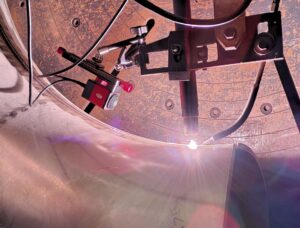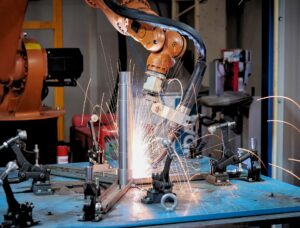Precision, safety, and the invisible strength behind nuclear infrastructure
In this blog, we’ll explore welding quality in the nuclear industry and why precision weld monitoring systems are critical for ensuring structural integrity and safety in nuclear infrastructure protection. In the nuclear industry, every weld is a potential point of failure—or a guarantee of safety. From reactors and pressure vessels to pipelines and storage tanks, welds are fundamental to the structural integrity and containment systems that protect both people and the environment. While many industries demand strong welds, the nuclear sector operates at a level where quality is not just important—it’s non-negotiable. Here’s why welding quality is so vital in this highly regulated, high-risk field.
1. Welds Are the Backbone of Safety-Critical Structures
In a nuclear power plant or facility, welded joints are found in:
- Reactor pressure vessels
- Steam generators
- Primary coolant piping
- Spent fuel pools and dry cask storage
- Structural steel supports and shielding
Each of these components must withstand high pressure, elevated temperatures, radiation exposure, and in some cases, corrosive environments. A poor-quality weld in any of these areas can lead to:
- Costly shutdowns or decommissioning
- Radiation leaks
- Mechanical failure
- Environmental contamination
2. Weld Failures Can Have Catastrophic Consequences
In other industries, a weld defect might lead to downtime or part replacement. In the nuclear industry, it could mean a full plant shutdown or even a public safety threat.
Common weld issues like porosity, lack of fusion, undercutting, or cracking—if undetected or unaddressed—can result in:
- Structural instability
- Breaches in containment systems
- Emergency events requiring immediate action
That’s why flawless execution, inspection, and documentation of every weld is built into the nuclear quality assurance process.
3. Welding Must Meet the Highest Regulatory Standards
Nuclear welds must conform to stringent codes and standards set by:
- ASME Boiler & Pressure Vessel Code (Section III and IX)
- U.S. Nuclear Regulatory Commission (NRC)
- International Atomic Energy Agency (IAEA)
- AWS D1.1/D1.6 and ISO 3834
These guidelines specify:
- Qualified welders and procedures
- Approved materials and filler metals
- Detailed visual and non-destructive inspection protocols
- Full documentation for traceability
Even a minor deviation from these codes can invalidate an entire weld and force costly rework.
4. Long-Term Performance Demands Long-Term Integrity
Nuclear components are designed to operate for 40–80 years or more. Welds must hold up to:
- Cyclic thermal loading
- Neutron irradiation and embrittlement
- Vibration and fatigue
- Corrosive chemical exposure (e.g., boric acid)
Achieving this level of durability means using high-quality weld processes, exacting workmanship, and real-time monitoring during welding—such as high-resolution welding cameras and post-weld testing.
5. Advanced Monitoring Tools Are Raising the Bar for Quality
To enhance weld quality and safety, many facilities now use:
- Welding cameras for real-time arc monitoring
- Automated welding systems for consistent weld profiles
- High-speed video capture to detect arc instability or metal transfer issues
- Digital inspection tools to improve accuracy and traceability
These technologies support early weld defect detection, better operator training, and compliance with digital documentation standards.
6. Public Trust Depends on Weld Integrity
Welding quality in the nuclear industry isn’t just about mechanical strength—it’s about public confidence. Any reported flaw, leak, or failure is magnified by media coverage and regulatory scrutiny. By upholding the highest weld quality standards, plant operators and fabricators also protect:
- Stakeholder confidence and public perception
- Brand reputation
- License renewals and project approvals
Conclusion: Welding Quality Is Nuclear Safety
In the nuclear world, strong, flawless welds are not optional—they are foundational. Investing in better welding techniques, skilled personnel, and modern inspection tools like welding cameras is an investment in safety, efficiency, and long-term plant reliability.
If you work in nuclear fabrication, inspection, or maintenance, ensuring top-tier welding quality is one of the most powerful ways to mitigate risk and deliver peace of mind.
Explore high-performance arc monitoring solutions for nuclear welds.
Talk to Mecaweld about how our advanced welding cameras can help you meet critical quality demands—while improving safety and documentation across the board.



